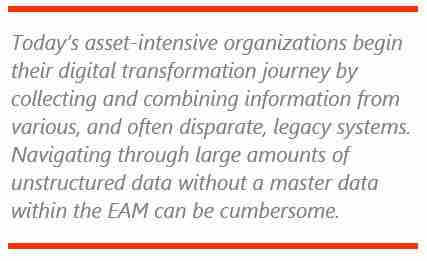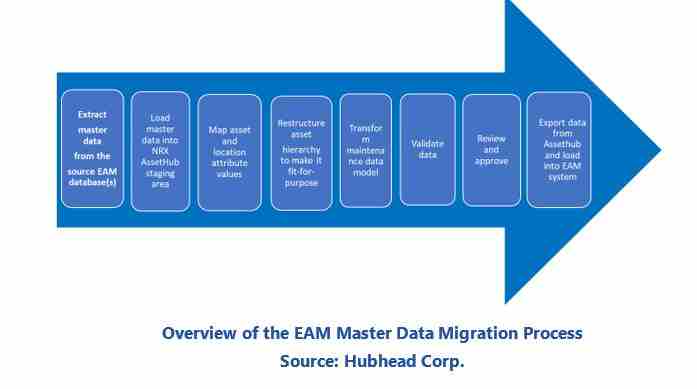

For many asset-intensive organizations, the implementation of their enterprise asset management (EAM) system is typically where efforts are focused. However, one critical and often overlooked area is the master data within the EAM, which drives the key  functionalities, such as maintenance planning and scheduling, spare parts inventory management, labor allocation, and similar areas. Taking the opportunity to optimize the EAM master data will help companies achieve the desired efficiencies and return on investments (ROI).
functionalities, such as maintenance planning and scheduling, spare parts inventory management, labor allocation, and similar areas. Taking the opportunity to optimize the EAM master data will help companies achieve the desired efficiencies and return on investments (ROI).
Today’s asset-intensive organizations begin their digital transformation journey by collecting and combining information from various, and often disparate, legacy systems. These can include cobbled-together maintenance planning and scheduling systems, shared spreadsheets, document management systems as well as production solutions.
These organizations must navigate through unprecedented amounts of data, most of which is unstructured, to even begin to come to any meaningful conclusions. For many it involves sifting through massive amounts of data residing in various siloed databases and data warehouses to try and make sense of it all to populate the EAM. These siloed systems can range from legacy EAM, spreadsheets held on shared drives, pdf manuals, and technical drawings provided by the engineering and construction contractors as part of the handover, all of which should be combined to and structured to provide the backbone of the EAM master data. Without a strategy or the tools to enable the staging and sharing of data there is zero visibility and traceability of the data being created, as typically it is hidden in separate siloed systems. Deleted this as it’s a repeat.
Central to the success of any effective EAM implementation is establishing a comprehensive data management plan and execution plan. These activities should include a wide variety of tasks, including data modeling, data cleansing, deduplicating, asset hierarchy development, key attribute population, and data mapping for the migration to the EAM and/or ERP system.
A good example of a solution with such capabilities can be seen in the NRX AssetHub a solution offered by HubHead Corp. AssetHub provides maintenance, reliability, and operations professionals in asset-intensive businesses with software solutions for visualizing, building, editing, organizing, approving, and sustaining high-quality asset and maintenance data.
The company employs a unified data management approach to share relevant data, and most importantly information, across departments and within asset-intensive organizations. Such an approach is needed to collect, clean, structure, and convert data into actionable information that can then be used by the various operations teams.
The company notes that customers using NRX AssetHub can save up to 50 percent of the time and costs typically incurred during a data build by making the process easier and faster. In addition, customers can increase wrench time by at least 25 percent by making it easier and faster for maintenance workers to find and act on critical information.
The Perstorp Group is a world leader in several sectors of the specialty chemicals market for a wide variety of industries and applications. Its chemicals are added to a wide range of products used every day at home and work. The company is experiencing high demand for powder and UV-cured coatings, plasticizers, synthetic lubricants, grain preservation, and animal health. Because of high growth in these important areas, equipment efficiency, productivity, and uptime are of critical importance to the company. Perstorp is in the process of consolidating their existing maintenance management systems into a truly enterprise-wide system that allows connectivity and synchronization of EAM and ERP data.
The company needed a well planned and executed master data management process, and one that includes specific tasks and actions for the all-important master data management process. The company collaborated with HubHead to realize their vision of enterprise-wide data connectivity through NRX AssetHub.
The first step to realize Perstorp’s vision involved extraction of all asset and maintenance master data from all source database(s), which included wide variety of data about equipment, locations, maintenance plans, job plans, tasks, material master data, spare parts, bill of materials (BOM) information and so on. All this gathered data is then loaded into NRX AssetHub staging area, where equipment data is captured, and original source ID data is also retained for future reference.
The next step involves mapping key EAM attribute values. For example, in Maximo implementations, mapping examples could include asset, location, and failure code values. In SAP implementations, mapping can include the class, catalog profile, and type of technical object fields.
In some cases, restructuring of asset hierarchy may also be needed to make the data fit-for-purpose. NRX AssetHub tree viewer helps with restructuring as it lets users simply drag and drop to tailor their asset hierarchy to conform to their corporate data standards. Perstorp was also able to assign locations and asset data quickly using the tree viewer. Duplication of different branches of the hierarchy is also possible to create templates including all the connected data such as maintenance, spare parts, documents and classifications to save time manually building similar branches.

Next, Perstorp was able to transform its maintenance data model by converting the existing maintenance master data (plans, task, etc.) into the target EAM data model. The company was then able to easily review and reconcile mandatory and recommended attributes and data standards compliance to validate the data. Lastly, the company exported data from NRX AssetHub staging area to target EAM system.
At Perstorp, the data migration plan is on a plant-by-plant basis connecting engineering, operations and maintenance teams. With the well-executed data management plan, the company can migrate data from legacy and other commercial maintenance management applications to its central EAM system. This has allowed the company to have one version of the truth accessible throughout the organization. The company can bring tremendous improvements to its asset management and digital transformation initiatives.
As asset-intensive organizations continue their efforts to improve asset management practices, they must have a strategy to manage their data effectively. Collecting and combining information from various sources, is a key element of an effective data management strategy as organizations need to structure, synchronize, and share data across the various internal teams and other internal and external stakeholders. Without a clear strategy and the tools to enable the staging and sharing of data there is zero visibility and traceability of the data being created, as typically it is hidden in siloed systems.
Solutions such as NRX AssetHub can be of great use to organizations looking to make sense of their data spread throughout their various systems. Organizations should start with a comprehensive plan and develop a clear strategy for data management. Effective data management sets up a solid foundation for adoption of advanced technologies such as analytics, machine learning, and artificial intelligence and helps organizations accelerate their digital transformation journey.
ARC Advisory Group clients can view the complete report at ARC Client Portal
If you would like to buy this report or obtain information about how to become a client, please Contact Us
Keywords: Enterprise Asset Management, EAM, CMMS, ERP, Analytics, Data, Data Management, AI, ML, Asset Performance Management, APM, ARC Advisory Group.

